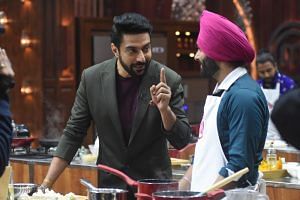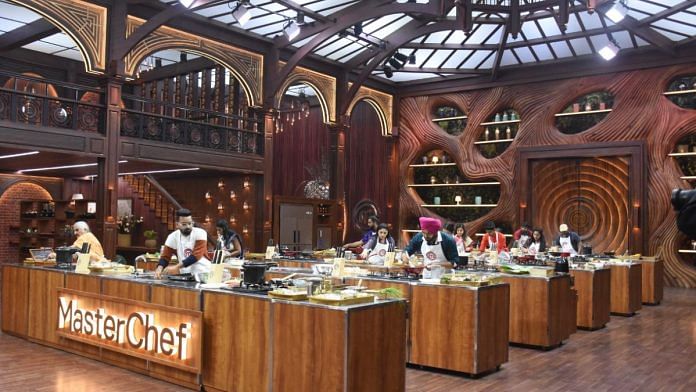For 36-year-old Aruna Vijay from Chennai, it’s a challenge to cook in a kitchen where meat is also prepared. But the camera-shy recipe developer — one of the 16 finalists at MasterChef India Season 7 — won’t let it get in the way of her dream to highlight Tamil Nadu’s rich food heritage through recipes she has honed over the years.
Twenty-five-year-old law graduate Gurkirat Singh Grover from Sirsa in Haryana has a different ‘meaty’ issue. He knows how to cook meat but does not eat it. “I have to rely on other contestants to tell me if my dish tastes good and if the meat is cooked well,” he says.
MasterChef India Season 7, which started airing on 2 January on SonyLIV, is proving to be one of the more diversity embracing seasons of the show ever since it was launched in 2010. Of the 16 cooks participating in the show, half are from eastern and northeastern India — West Bengal, Odisha, and Assam — regions that often go unrecognised in the larger story.
This isn’t a fluke. This season is called ‘India ke food ka tyohar’ (a celebration of Indian food). There’s reason to hope, therefore, that the upcoming episodes will showcase more of the vast range of practices and habits that come under the umbrella of Indian cuisine — from the ubiquitous idli-sambar to lesser-known preparations like akini chokibo or cooked snails with perilla seeds from Nagaland.
In the first episode of this season, in which contestants vied for the coveted white aprons, the dishes that the judges picked included less-known regional preparations, some with a fusion of contemporary and traditional techniques.

Kolkata’s Dyuti Banerjee wooed the judges with her version of the phena bhaat, a simple Bengali rice porridge. She took it a notch higher with the addition of a Korean-style fried egg and gondhoraj lebu (a type of lime) leaves. Avinash Pattnaik of Odisha gave a very cerebral twist to the pitha — a sweet pancake — with aparajita or blue pea flower. He used the flower to add a tinge of blue to his dish with the taste remaining unaltered.
The show also has 78-year-old Urmila Ben, the oldest contestant in any of the MasterChef India seasons so far. She can easily whip up patode or stuffed colocasia leaf rolls.
“Defining food takes away its essence and restricts it. India as a nation officially emerged in 1947, but [its] food has always existed,” says celebrity chef Ranveer Brar, one of the three judges on MasterChef India Season 7. The other two judges are Vikas Khanna and Garima Arora, both of whom have Michelin stars under their belts.
Also read:
A ‘meat-ing’ of cuisines
In the Australian and US versions of MasterChef, contestants come with personal food preferences, from being vegetarian and vegan to being gluten-free. But such choices are not laced with political undertones. In India, food is often associated with religion and caste-based notions of ‘purity’.
Back in 2015, MasterChef India Season 4 triggered a controversy with participants having asked to prepare only vegetarian dishes. Since then, though, such restrictions have been dropped from the show.
This may have something to do with the fact that despite India’s reputation as a vegetarian country, the majority of people do eat meat. The fifth round of the National Family and Health Survey (NFHS), conducted between 2019 and 2021, showed that 83.4 per cent of Indian men and 70.6 per cent of women in the 15-49 age group consume meat. While chicken, mutton, and fish recipes are widely ‘accepted’ in the country, pork and beef are unlikely to ever make an appearance in an Indian cooking contest due to the religious baggage they carry.
Even vegetarian contestants like Aruna Vijay acknowledge that meat is part of the country’s food culture and that it is possible for different culinary practices to co-exist — even in the same kitchen.
“It is a part of the experience of being in a competition,” Vijay says. “We have to make more efforts to make vegetarian food more appealing. It is challenging, but also fun.”
She is sensitive to the fact that availability and access influence food choices. “Food is also about maximum nutrition with least expenditure. Not everyone can afford to eat certain food items,” Vijay says. “In certain areas [of Odisha], ant chutney is the cheapest source of protein.”
For Odisha’s Avinash Pattnaik, it is important to promote awareness about diverse cultural and religious food practices.
“There are temples in Odisha where fish is offered,” says the Bhubaneswar-based cook. “Meat is offered as prasad in many places. It is about belief, but also knowledge.”
Also read: Puran Poli to pickles—In Dapoli, women are bringing home-chef revolution to Konkan food
Diversifying the playing field
Authentic Northeast Indian cuisine has never been featured in any season of MasterChef India so far. And for the first five seasons, there were hardly any contestants from the Northeast or East India either.
But things changed in Season 6, which aired in 2019. Abinas Nayak from Odisha was crowned the winner that year. Smrutisree Singh, also from Odisha, was one of the top four finalists. Mahendra Thulung, a 32-year-old entrepreneur and interior designer from Darjeeling, became the first Gorkha contestant on the show.
And Masterchef India has only upped the diversity game this year.
One of the mystery box challenges includes using roselle, hibiscus plant, as an ingredient. This plant is called gongura in Andhra Pradesh and is used in many dishes, including dal. In Manipur, it is known as sougri and is used to make chutneys.
For some contestants, the show is an opportunity to clear up misconceptions about their cuisines and perhaps convert a few along the way.
“People think that we only eat non-vegetarian food in the Northeast, but we have so many unique vegetables and herbs that are not just tasty but also good for health,” says Nayanjyoti Saikia, a young Assamese chef. “We have a unique cuisine, we do not use spices or oil, and it is very healthy.”
Also read: Are you a picky eater? This UK study says the habit could be in your DNA
Tryst with ‘home’ food
Homemade food acquired new-found desirability after the 2020 lockdown. With no cooking services and restaurant deliveries shut, many took to their kitchens to experiment. Some even monetised their new passion.
Others gave more thought to food than they had ever before. Vijay, for one, started documenting recipes during the lockdown, especially those that were handed down in families through women.
It comes as no surprise then that MasterChef Season 7 is focusing on people who identify as ‘home chefs’ and do not necessarily have formal training in cooking.
And the focus on homemade dishes has made one thing clear — it is no easy job. The younger, well-travelled, and social media-savvy generation is bringing fresh perspectives and ingredients to tried-and-tested family recipes and regional specialities.
For Gurkirat Singh Grover, his small-town roots have only fuelled his desire to elevate locally prepared dishes to a fine dining experience. “I aim to turn Indian ingredients international because every fancy ingredient isn’t available in small towns,” he says.

Grover fashioned the rustic delicacy of litti chokha — stuffed dough balls eaten with mashed and tempered vegetables — into a quiche.
Modernising the traditional — and celebrating it too — has become a global phenomenon. There is a hunger for the ‘authentic’, storytelling, and sustainability across cooking shows.
In 2021, Kishwar Chowdhury, a finalist in MasterChef Australia Season 13, showcased her Bangladeshi heritage by rustling up what she called “smoked rice water”. This dish was a gourmet spin on the panta bhat (West Bengal) or geel bhat (Bihar) or the pakhala (Odisha) — ‘the poor’s breakfast’.
Chowdhury’s dish consisted of water-fermented rice, white soy ginger sardines as sides, smoked potato mash, and onions and chillies with lemon. The preparation was not just a homage to her roots but also displayed culinary techniques that got a thumbs-up from the judges.
Also read: The good, the bad and the idli
Sustainability with a side of tradition
Famous for her desserts and rich roasts, food ‘goddess’ Nigella Lawson created a stir in November 2020 when she whipped up a curry of banana peels and cauliflower in her show Cook, Eat, Repeat.
The same year, in April, TV personality and chef Nadiya Hussain on Good Morning Britain extolled how banana skins could be prepared as burger fillings. Everyone was making banana bread during the worldwide lockdown due to the pandemic, she said, but they could put the peels too to good use. Hussain’s parents are originally from Bangladesh where eating vegetable peels is common.
The same goes for West Bengal where recipes evolved to include stems, peels, and other vegetable ‘wastes’. Food historians have traced the cultural roots of such vegetarian delicacies of the state — they emerged out of ‘widow cuisines’ that restricted food choices for women whose husbands died. These women learnt to make most of the ingredients before them, without using onion or garlic.
“From thor bhaja and labra to pora, innovative dishes soon became an integral part of Bengali cuisine itself, especially on the days [when] people did not eat meat,” says Priyanka Kundu Biswas, a contestant from Kolkata. Marrying and shifting to Kolkata made her more aware of the food in the region, after which she started incorporating the methods in her cooking.
And several contestants on MasterChef India Season 7 aren’t shying away from showing more examples of ‘no-waste’ cooking practices in India — from melon rinds in parts of Rajasthan to deep frying banana skins in Kerala.
“Balance is not a new concept. Traditional food, which many of us are moving away from, has always been both healthy and balanced,” says Odisha’s Patnaik.
Also read:
Culture for one, taboo for another
There’s no lack of zeal among this year’s contestants at MasterChef India to win — but it also comes with an eagerness to learn from each other.
Many said that cooking together has made them dispel their own prejudices about the food cultures of other regions. “I did not know [that] there were so many podis (dry condiments). Once I go back home, I will now experiment with food that includes it,” says Kamaldeep Kaur of Ludhiana.
MasterChef India Season 7 has become a lesson in sociology.
“As a food enthusiast, I have tried to eat different things that are not part of my culture and are even considered taboo. What is edible for one culture or community is taboo for another,” says Avinash.
(Edited by Asavari Singh and Humra Laeeq)



